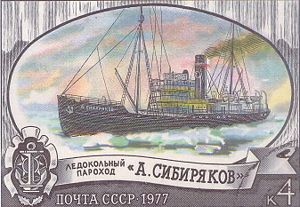A. Sibiryakov (icebreaker)

A. Sibiryakov in a Soviet postage stamp
|
|
| History | |
|---|---|
| Name: | A. Sibiryakov |
| Owner: | Glavsevmorput, Soviet Union |
| Port of registry: | Archangelsk |
| Ordered: | 1908 |
| Builder: | D & W Henderson Ltd, Glasgow |
| Yard number: | No 464 |
| Laid down: | 23 November 1908 |
| Launched: | 1909 as Bellaventure |
| Completed: | 1909 |
| Acquired: | 1916 |
| Fate: | sunk by German cruiser Admiral Scheer 24 August 1942 |
| General characteristics | |
| Type: | Icebreaker |
| Tonnage: | 1,383 tons |
| Length: | 76.5 m (251 ft) |
| Beam: | 10.8 m (35 ft) |
| Draught: | 6 m (20 ft) |
| Ice class: | icebreaker |
| Installed power: | 2,360 hp (1,760 kW) |
| Propulsion: | 1 shaft steam engine, 2 boilers |
| Speed: | 13 knots (24 km/h; 15 mph) |
| Crew: | 104 |
| Notes: | armed with a single 4 in (102 mm) gun in 1942 |
A. Sibiryakov (Russian Александр Сибиряков) was a Soviet icebreaker which was active in the Russian Arctic during the 1930s. She was built in 1909 in Glasgow and was originally the Newfoundland sealing steamer Bellaventure. After being purchased by Russia in 1916, she was renamed A. Sibiryakov. Her Russian name was chosen in honour of Aleksandr Mikhaylovich Sibiryakov, an Imperial Russian gold mine proprietor. Sibiryakov financed explorations to Siberia, such as Adolf Erik Nordenskiöld's, and also took part in some expeditions of his own.
A. Sibiryakov made the first successful crossing of the Northern Sea Route in a single navigation without wintering. This historic voyage, which had been Mikhail Lomonosov's dream, was organized by the All-Union Arctic Institute (presently known as the Arctic and Antarctic Research Institute).
A. Sibiryakov sailed on 28 June 1932 from the Krasny (previously Sobornoy) docks in Arkhangelsk, crossed the Kara Sea and chose a northern, unexplored way around Severnaya Zemlya to the Laptev Sea. In September, after calling at Tiksi and the mouth of the Kolyma, the propeller shaft broke and the icebreaker drifted for 11 days. However, A. Sibiryakov crossed the Chukchi Sea using improvised sails and arrived in the Bering Strait in October. A. Sibiryakov reached the Japanese port of Yokohama after 65 days, having covered more than 2,500 miles (4,000 km) in the Arctic seas. This was regarded as a heroic feat of Soviet polar seamen and Chief of Expedition Otto Schmidt and Captain Vladimir Voronin were received with many honors at their return to Russia.
...
Wikipedia
